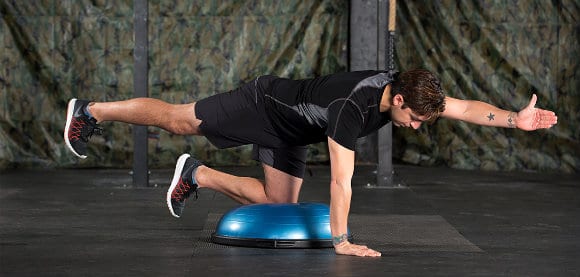Bird Dog
The bird dog is a free body exercise that “teaches” the body how to stabilize the lumbar vertebrae during those movements that simultaneously affect the upper and lower parts of the body. It is an excellent ally for sports activities, as well as for health in general.
The importance of stabilizing the lumbar spine should never be underestimated, as it is a fundamental mechanism, which is called into question by almost any activity we go to support.
Furthermore, let's not forget that a strong lower back allows us to prevent many lumbar pathologies that are otherwise, as well as widespread, wearing.
The benefits that we can obtain from the practice of the bird dog are innumerable: in addition to the work on stabilization, it enhances the response to the efforts of the core muscles, helps to improve the alignment of the spine and hips, gives stability to the shoulders and - not last - it helps to improve proprioception.

A muscular back is generally interpreted as "strong": in reality, there are several functions that need to be trained.
The bird dog causes the lumbar segment of the back - and the relative musculature - to "save" during the execution of the movements: in fact, this part of the body often tends to be overloaded with that work that can instead be shared with the hips and the abdominals.
1. Muscles involved
The bird dog mainly involves the spinal erectors. Synergists are buttocks, trapezius and deltoids. A plethora of other muscles then act as stabilizers, to keep the core engaged and the body stable.
Given its simplicity, the bird dog can be considered an exercise for beginners; this does not exclude that more experienced athletes may have problems - mobility and coordination, above all - approaching this movement for the first time.
2. How is it done?
Apparently, the execution of the bird dog is the simplest.
- Kneel on all fours on a mat, with hands and legs slightly apart.
- He raises an arm in front of him, keeping it at the side of the head, and at the same time he raises the opposite leg behind the body.
- The position is maintained for a fixed time, returns to the starting position, and is repeated with the opposite limbs.
The exercise must be performed slowly. The limbs should be raised and lowered smoothly, with regularity.
During the change of sides, the core must remain taut.
During throughout the execution the spine must remain neutral and, in the final position, a straight line must be drawn between the arm, back and leg: to avoid rotations of the torso, the raised leg must be parallel to the ground, and must never be higher than the level of the hip.
The neck must not bend backwardsnor does the head dangle forward.
The shoulders must not lean forward.
If you don't have a mat, it's important to place something soft, like a towel, under your knees.
3. Variants
The bird dog can be performed in series of five or six repetitions, in which the final position is held for about ten seconds. It is possible to keep it for longer, but the body tends to get used to this tension very quickly.

At this point it becomes necessary to use variations to make the exercise more challenging:
- Gods can be applied ankle weights, and hold small dumbbells in your hand.
- By setting the starting position to that of the push-ups, the exercise requires an even more rigid core and the activation of an even more important stabilization.
- Similarly, you can lie down on a bosu ball, as if hugging it. The ball becomes our support (it is important that this has a size that allows hands and feet to touch the ground simultaneously). To vary the exercise - or further complicate it - you can experiment with the position of the hips with respect to the top of the ball.
- Il bird dog on bench it is the last of the variants proposed here, and one of the most satisfying in which to try your hand. Our starting position is one of balance on a bench; the feet, which in the bird dog would touch the ground, are actually suspended behind us. Having to maintain this position exponentially increases the intensity, but also the effectiveness, of the exercise. There are also other factors of difficulty: we have one less point of contact with the ground (the foot); we must stabilize on a soft as well as narrow surface. The hands are also forced to actively participate in the effort, as they must cling to the edge of the bench to allow us to remain in balance.


























